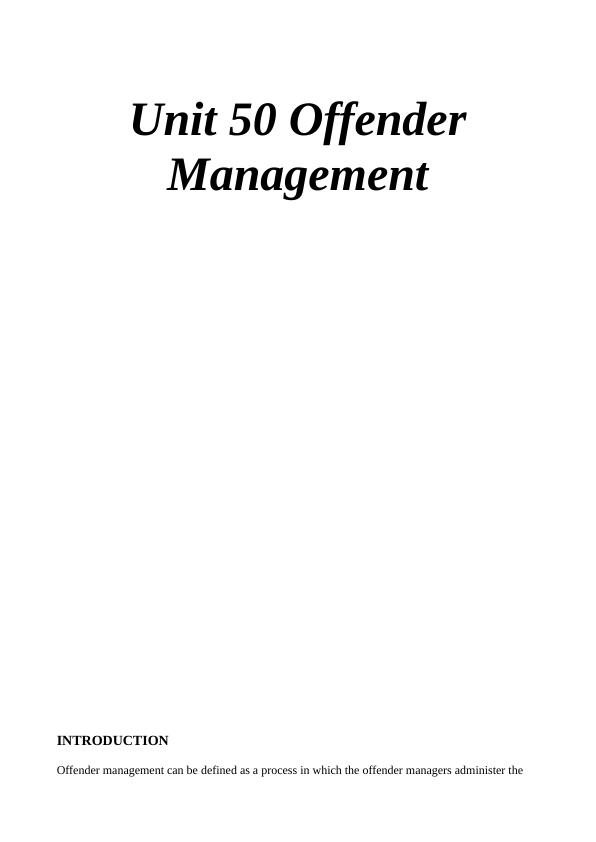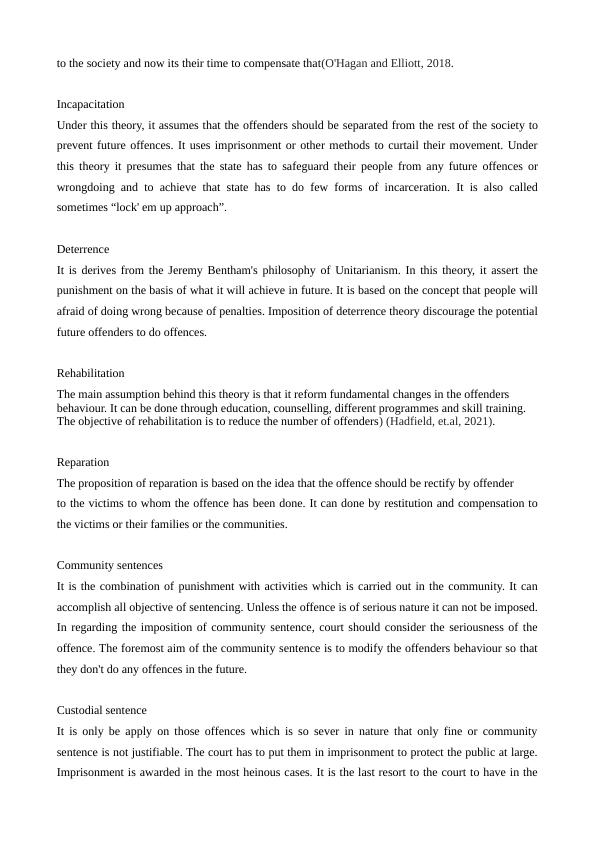Unit 50 Offender Management: Theories of Punishment, Government and Non-Government Organizations, and Sentence Plans
Added on 2023-06-10
9 Pages3814 Words324 Views
Unit 50 Offender
Management
INTRODUCTION
Offender management can be defined as a process in which the offender managers administer the
Management
INTRODUCTION
Offender management can be defined as a process in which the offender managers administer the

activities of the offenders in as well as out of the prison. It is all about the supervision of the time of
the criminals at the time when they are being sentenced to jail and when they will become a part of
the community after completing the punishment. The major objective of the offender managers is to
reconstruct the individuals effectively so that the chances of doing any offence will be less in future.
Basically these managers are associated with the National Offender Management Service(NOMS)
and Community Rehabilitation Company(CRC) (Fox, et.al, 2018) . These agencies are designed by
the government of United Kingdom in order to prevent crime rates in the country. These structures
acts as a watchdog which keeps an eye on the acts of the offenders. This report will explain the
concept of offender management in relation with the government and non- government
organisations which helps in the management of the offender. It further includes the examples of
sentence plans and its importance.
MAIN BODY
Task 1
The case study referred in this report is about a double murder case of two girls in Cambridgeshire,
in England. The girls were 10 years of age. The accused that is Ian Kevin Huntley killed the
children on August 4, 2002 by taking the two girls with him by alluring them. The accused took
them to his residence where he was working as a caretaker of a school. Afterwards, Irvin threw the
bodies of Marine and Jessica in an irrigation well. After 14 days of search, the police found the
bodies of the victims. This case is known as Soham murders. Further, the accused was convicted
and the court has given him the sentence of two term of life imprisonment which was converted into
40 years.
Theories of punishment and the principle for custodial and community sentences-
The theories of punishment are:
1.Retribution
2.Incapacitation
3.Deterrence
4.Rehabilitation
5.Reparation
Retribution
It is one of the oldest theories of punishment which can be traced backed its root to the Bible ,
calling for an “eye for an eye, a tooth for a tooth and a life for a life”. The theory of retribution
refers that the human being is able to make a wise decision and should understand their decision
consequences. It says that the offenders must be punished for their offences. They have make harm
the criminals at the time when they are being sentenced to jail and when they will become a part of
the community after completing the punishment. The major objective of the offender managers is to
reconstruct the individuals effectively so that the chances of doing any offence will be less in future.
Basically these managers are associated with the National Offender Management Service(NOMS)
and Community Rehabilitation Company(CRC) (Fox, et.al, 2018) . These agencies are designed by
the government of United Kingdom in order to prevent crime rates in the country. These structures
acts as a watchdog which keeps an eye on the acts of the offenders. This report will explain the
concept of offender management in relation with the government and non- government
organisations which helps in the management of the offender. It further includes the examples of
sentence plans and its importance.
MAIN BODY
Task 1
The case study referred in this report is about a double murder case of two girls in Cambridgeshire,
in England. The girls were 10 years of age. The accused that is Ian Kevin Huntley killed the
children on August 4, 2002 by taking the two girls with him by alluring them. The accused took
them to his residence where he was working as a caretaker of a school. Afterwards, Irvin threw the
bodies of Marine and Jessica in an irrigation well. After 14 days of search, the police found the
bodies of the victims. This case is known as Soham murders. Further, the accused was convicted
and the court has given him the sentence of two term of life imprisonment which was converted into
40 years.
Theories of punishment and the principle for custodial and community sentences-
The theories of punishment are:
1.Retribution
2.Incapacitation
3.Deterrence
4.Rehabilitation
5.Reparation
Retribution
It is one of the oldest theories of punishment which can be traced backed its root to the Bible ,
calling for an “eye for an eye, a tooth for a tooth and a life for a life”. The theory of retribution
refers that the human being is able to make a wise decision and should understand their decision
consequences. It says that the offenders must be punished for their offences. They have make harm

to the society and now its their time to compensate that(O'Hagan and Elliott, 2018.
Incapacitation
Under this theory, it assumes that the offenders should be separated from the rest of the society to
prevent future offences. It uses imprisonment or other methods to curtail their movement. Under
this theory it presumes that the state has to safeguard their people from any future offences or
wrongdoing and to achieve that state has to do few forms of incarceration. It is also called
sometimes “lock' em up approach”.
Deterrence
It is derives from the Jeremy Bentham's philosophy of Unitarianism. In this theory, it assert the
punishment on the basis of what it will achieve in future. It is based on the concept that people will
afraid of doing wrong because of penalties. Imposition of deterrence theory discourage the potential
future offenders to do offences.
Rehabilitation
The main assumption behind this theory is that it reform fundamental changes in the offenders
behaviour. It can be done through education, counselling, different programmes and skill training.
The objective of rehabilitation is to reduce the number of offenders) (Hadfield, et.al, 2021).
Reparation
The proposition of reparation is based on the idea that the offence should be rectify by offender
to the victims to whom the offence has been done. It can done by restitution and compensation to
the victims or their families or the communities.
Community sentences
It is the combination of punishment with activities which is carried out in the community. It can
accomplish all objective of sentencing. Unless the offence is of serious nature it can not be imposed.
In regarding the imposition of community sentence, court should consider the seriousness of the
offence. The foremost aim of the community sentence is to modify the offenders behaviour so that
they don't do any offences in the future.
Custodial sentence
It is only be apply on those offences which is so sever in nature that only fine or community
sentence is not justifiable. The court has to put them in imprisonment to protect the public at large.
Imprisonment is awarded in the most heinous cases. It is the last resort to the court to have in the
Incapacitation
Under this theory, it assumes that the offenders should be separated from the rest of the society to
prevent future offences. It uses imprisonment or other methods to curtail their movement. Under
this theory it presumes that the state has to safeguard their people from any future offences or
wrongdoing and to achieve that state has to do few forms of incarceration. It is also called
sometimes “lock' em up approach”.
Deterrence
It is derives from the Jeremy Bentham's philosophy of Unitarianism. In this theory, it assert the
punishment on the basis of what it will achieve in future. It is based on the concept that people will
afraid of doing wrong because of penalties. Imposition of deterrence theory discourage the potential
future offenders to do offences.
Rehabilitation
The main assumption behind this theory is that it reform fundamental changes in the offenders
behaviour. It can be done through education, counselling, different programmes and skill training.
The objective of rehabilitation is to reduce the number of offenders) (Hadfield, et.al, 2021).
Reparation
The proposition of reparation is based on the idea that the offence should be rectify by offender
to the victims to whom the offence has been done. It can done by restitution and compensation to
the victims or their families or the communities.
Community sentences
It is the combination of punishment with activities which is carried out in the community. It can
accomplish all objective of sentencing. Unless the offence is of serious nature it can not be imposed.
In regarding the imposition of community sentence, court should consider the seriousness of the
offence. The foremost aim of the community sentence is to modify the offenders behaviour so that
they don't do any offences in the future.
Custodial sentence
It is only be apply on those offences which is so sever in nature that only fine or community
sentence is not justifiable. The court has to put them in imprisonment to protect the public at large.
Imprisonment is awarded in the most heinous cases. It is the last resort to the court to have in the

End of preview
Want to access all the pages? Upload your documents or become a member.
Related Documents
Offender Management: Theories of Punishment, Government and Non-Government Organizations, Sentence Plans, and Reoffending Rateslg...
|13
|3908
|337
Sentencing Considerations by Judges in Singapore: A Case Studylg...
|11
|3030
|415
Unit 50 Offender Management: Case Study Analysislg...
|13
|3769
|288
Principles of Criminal Law: Analysis and Evaluationlg...
|6
|1349
|240
Offender Management: Theories, Organizations, and Effectivenesslg...
|9
|2005
|26
Capital Punishment - Assignmentlg...
|7
|1667
|280
